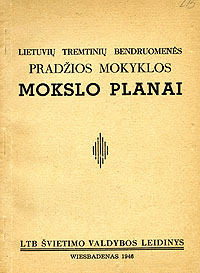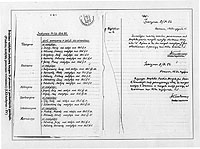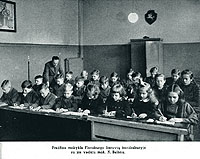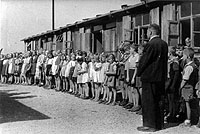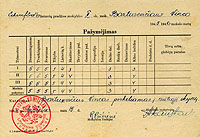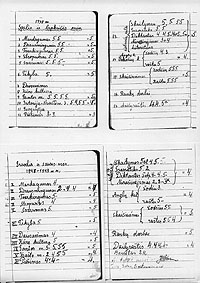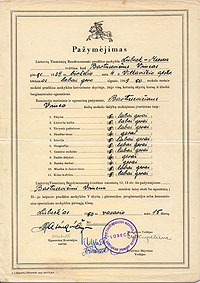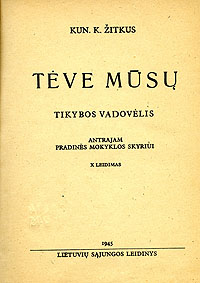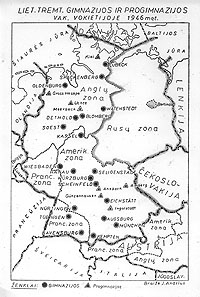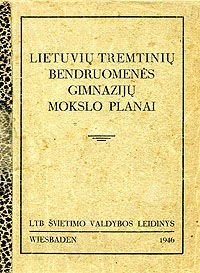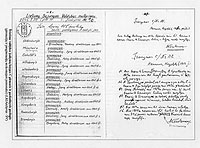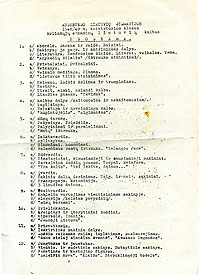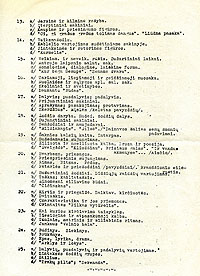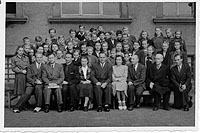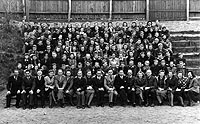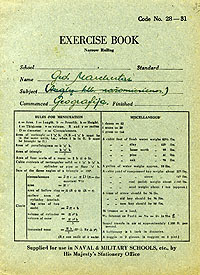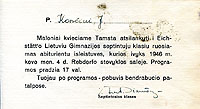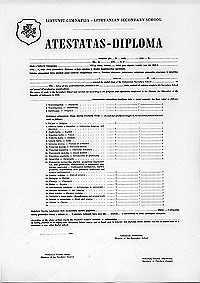EDUCATION
ELEMENTARY SCHOOLS
Elementary schools in lithuanian DP camps (as well as in independent Lithuania) were formed in two levels, but schooling continued not 6, but 8 years. This change, made by Educational Board, set that first level consisted of first four learning years, and the second of remaining four. There were not a lot of second level elementary schools, they were established in places with no gymnasiums or training-schools. The gymnasium learning program subjects were lectured here, because in time they grew into gymnasiums or progymnasiums. There were more of first level schools. In 1945-1946 even 112 of them are registered. The largest number of juniors was registered in 1947 4151, of teachers during the 1947-1948 school year 360. The numbers reduced in 1949 because of intensified depopulation regarding migration: there were 79 schools, 3691 students, 296 teachers left. Lithuanian language, religion, mathematics, recognition of the motherland, history, geography, natural science, arts and crafts, music, singing and physical education were taught in the first level of primary schools.
Teachers in DPs primary schools faced the same requirements as in the Republic of Lithuania. The first level schools teachers had to be graduated from teachers seminary, the second level pedagogical institute.
| The Lithuanian Refugees Community's primary school's study schedules, Wiesbaden, 1946 National Library of Lithuania, LA139 |
|
| The Educational Board order for affirmation of school personnel Lithuanian Cultural Institute in Germany (LKI) |
|
| Flensburg Lithuanian primary school, In Dienos be tėvynės: Flensburgo lietuvių metraštis (Days without motherland: Flensburg Lithuanian chronicle), 1946 National Library of Lithuania, A(LKA) 30/946 |
|
| Munich-Lohengrin camp primary school in 1947 Lithuanian Cultural Institute in Germany (LKI) |
|
| Eckernförd primary school student's Vincas Bartusevičius 1st grade graduation certificate, 1945/1946 From Vincas Bartusevičius personal archive |
|
| Primary school student's grade book From Vincas Bartusevičius personal archive |
|
| Lübeck-Meesen primary school graduation certificate From Vincas Bartusevičius personal archive |
|
| K. Žitkus. Tėve mūsų (Paternoster). Religious textbook for the second elementaty school class, Tubingen, 1945 National Library of Lithuania, A(LKA) 28/945 |
PROGYMNASIUMS AND GYMNASIUMS
During the 1947-1948 academic year 16 progymnasiums and 25 gymnasiums functioned in German DP camps. They were attended by 3262 students. A task was set of these learning institutions to work with a thorough education securing plan and to prepare students for higher education establishments. Educational Board declaration legitimated 4 years progymnasium and set 8 years learning with reinforced foreign language teaching in gymnasiums. For the lithuanian youth, which found themselves in a strange foreign land, a special social education program was prepared, which formed moral and civil students' views. Next to the most important considered things, like - lithuanian language and literature, Lithuanian history and geography a lot of gymnasiums also offered various crafts lessons and improved number of foreign language classes. In 1947 Germany gymnasium pupils were educated by 700 pedagogues. Most of the teachers were longevous Lithuanian gymnasiums pedagogues, other field specialists, primary school teachers, students, in rare cases even former university professors. Almost one thousand pupils got their certificates during 1945 1949. These certificates were accepted in Germany and permitted of possibility to continue studies in high school. Lithuanian refugee schools did not fade even in 1949, when the mass emigration from DPs started and lots of lithuanian educational institutions in Germany were closed. In the fall of 1950 „Vasario 16“ gymnasium was established in Dypholz barracks the most famous lithuanian school which is continuously working till now.
| The map of lithuanian exile gymnasiums and progymnasiums in Germany, 1946 Lithuanian Cultural Institute in Germany (LKI) |
|
| LTB gymnasiums education plans, Wiesbaden, 1946 National Library of Lithuania, A(LKA)129/946 |
|
| Educational Board order for affirmation of gymansium's directors Lithuanian Cultural Institute in Germany (LKI) |
|
| Augsburg Lithuanian gymnasium 1948/1949 4th grade Lithuanian language exam National Library of Lithuania, F 179-220 |
|
| Augsburg Lithuanian gymnasium 1948/1949 4th grade Lithuanian language exam National Library of Lithuania, F 179-220 |
|
| Students and teachers of the Hanau gymnasium in 1949 Lithuanian Cultural Institute in Germany (LKI) |
|
| Lithuanian gymnasium in Oldenburg National Library of Lithuania F 28-227 |
|
| Students' G. Marchertas geography notes, National Library of Lithuania F 28-61 |
|
| An invitation to Eichstätt lithuanian gymnasium's senior prom, 1946 National Library of Lithuania F 28-139 |
|
| Lithuanian secondary school diploma, From Vincas Bartusevičius personal archive |
HIGHER AND HIGH SCHOOLS
The Lithuanian academic community was also hurt by Soviet occupation. In 1944 more than a half professors and above 2000 students left Lithuanian High Schools. Part of them were accepted in Tubingen, Freiburg, Heidelberg, Frankfurt, Stuttgart and Hannover universities, 300 lithuanians studied in international university in Munich, which was run by UNRRA, others formed first refugee camps high school communities. The biggest part of lithuanian academic professorate and students gathered in the Baltic University in Hamburg-Pineberg in 1946-1949. 49 lithuanian lecturers worked here the first year, among them famous professors V. Stanka (a rector at Baltic University 1948-1949), V. Manelis, J. Puzinas, S. Kairys, brothers Biržiškos, J. Šimoliūnas, J. Čiurlys. 440 lithuanians studied in the Baltic University in 1946. 16 of them graduated, two were given doctoral degree. Exclusive was artist V. K. Jonynas initiative in 1946 he established Freiburg art and trade high school (proceeded till 1949), it gathered the most famous independent Lithuania artists and talented youth for a teamwork. Graphics, sculpture, painting, pottery and drapery studies were taught by V. Vizgirda, A. Valeška, A. Galdikas, A. Marčiulionis, T. Valius, A. Muraitis, A. Tamošaitis, V. Kasiulis, T. Zikaras. During the first academic year 46 lithuanians studied here former Vilnius and Kaunas high art schools and crafts school students, which later became famous artists. In 1948 1949 school diplomas were received by V. Ignas, A. Elskus, E. Urbaitytė, A. Mončys, L. Mozoliauskas, R. Viesulas. Apart from these higher education establishments in the exile also functioned Lithuanian rivers hydrology fathers founded higher technology schools in Kirchheim, Augsburg, Marine school in Flensburg, nursing schools in Swabia Gmund and Dilingen, business school in Ravensburg, 12 trade schools.
| The appeal of the Baltic University steering committee's lithuanian section, National Library of Lithuania, F52-302L |
|
| Lithuanian students' 1947/48 winter semester in Germany statistics, National Library of Lithuania, F52-304L |
|
| Lithuanian students in the Baltic University, In DP Baltic camp at Seedorf , Hamburg, 1947 National Library of Lithuania, C(LKA)angl.7/947 |
|
| Baltic University's professors and students camp in Hamburg Lithuanian Cultural Institute in Germany (LKI) |
|
| The list of the Baltic University's graduates National Library of Lithuania F52-307L |
|
| Lithuanian professors of the Baltic University in 1947, Pabaltijo universiteto 50-ties metų sukaktį minint (50th anniversary of the Baltic University), Chicago, 1996 National Library of Lithuania A(LKA)17/996 |
